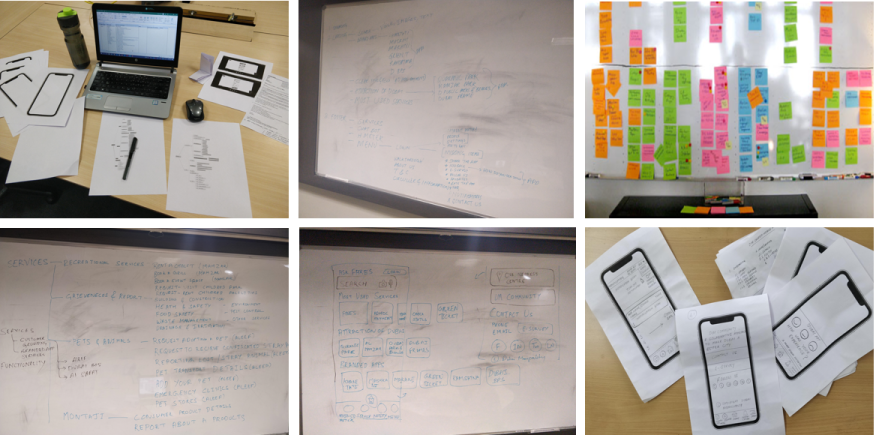A Product, Service & UX Designer.
Case Study #3
The UX Behind Dubai’s Unified Public Services App
As the UX Designer & Strategist, I took on the challenge of merging 16 fragmented apps into a single, unified platform for Dubai Municipality, ensuring a seamless, intuitive, and efficient digital experience for all users.

Some sections of this portfolio have been intentionally blurred or modified to honor NDAs and protect sensitive client information. For a more detailed walkthrough, please feel free to get in touch.
Context
Dubai Municipality initiated a single Unified Mobile application by consolidating existing 16 mobile applications. The Unified Mobile application benefited not only the citizens of UAE but also improved the brand value of Dubai Municipality. It aligned with Dubai Municipality’s mission to plan, develop, and manage a city that provided excellent services, promoting ease of living. The Unified Mobile Application provided countless public services and seamless e-services around the clock to the people of Dubai. Most of Dubai Municipality’s services were made available to UAE citizens through this single native application, which featured advanced functionalities such as single sign-on, payment gateway integration, and a wealth of information.
Role, Deliverables & Tools Used

Design Role
-
Stakeholders and business alignment
-
Requirement gathering
-
Internal team alignment
-
UX activity plan
-
End-to-end UX activity execution
-
Cross-function team coordination and pixel-perfect implementation assurance

Deliverables
-
As-is user journeys
-
Research reports
-
Usability study or evaluation
-
Mind maps
-
Key personas
-
To-be user journeys
-
User flows
-
Information architecture
-
Wireframes and clickable prototypes
-
Design evaluation and report
-
User interface design
-
Design style guidelines & assets

Tools
-
Axure RP8
-
Figma
-
Photoshop
-
Illustrator
-
Mendix
-
SurveyMonkey
-
MS Word & Excel
UCD Process

Mission
-
To design a seamless user experience by consolidating existing 16 native mobile applications for the citizens of Dubai
-
Single native application that provides countless public services and seamless e-services around the clock to the people of Dubai
-
Reduced the unnecessary process / workflows / touch-points etc.
-
Enhance features / functionalities that provides a more personalized user experience, making the entire interface more clear, balanced, aesthetically pleasing, simple and stylish with good usability.
-
Target users: Individuals, Emiratis / Non-Emiratis, Contractor / Consultant/ Developer.

Assumptions
I made some general assumptions about the people of Dubai and their most used app in daily activities:
-
They desire one-click access to most Dubai Municipality services.
-
They require real-time updates, notifications, and the ability to track their queries and status.
-
They prefer managing tasks online rather than visiting municipality offices physically.
-
They aim to stay updated on community news, groups, or any announcements from Dubai Municipality.
Research
To better understand the Dubai people needs for DM services, I conducted an online survey with different age groups and demographics.

Heuristics Evaluations
A usability study was conducted on 16 existing mobile applications to identify overarching problem areas and explore opportunities for reusability.

Key Personas & To-Be User Journeys
The insights I gained from surveys and user interviews informed the creation of personas, highlighting common patterns, challenges, and pain points. This process deepened my empathy for users.
Defining and reimagining user journey maps further enhanced my understanding of user expectations and their experiences with the unified app.





Competitors Analysis
I conducted a comprehensive competitor analysis of recommended mobile apps to map and address potential gaps in the new DM-Unified mobile app.

Brainstorming & Ideation
-
Rough mind maps were created to organize the information flow, encompassing all 16 apps.
-
Information architecture was defined through a collaborative closed card sorting exercise with stakeholders.
-
This exercise helped us reimagine the future navigation structure of the unified mobile app.


Wireframes
Initial wireframes were sketched on paper before transitioning to digital formats. This approach allowed for rapid iteration and early detection of usability issues during design evaluations. Subsequently, usability findings were integrated into the digital wireframes.

User Interface Design
-
Designs were developed from scratch without an existing design system. It took some time to explore the appropriate metaphors, patterns, and color schemes that resonated well with users.
-
During the usability testing phase, multiple feedback points were received. This led to 5-6 rounds of design iterations before finalizing on the experience & aesthetic aspects.

What makes the “Unified Mobile Application” different from others!


